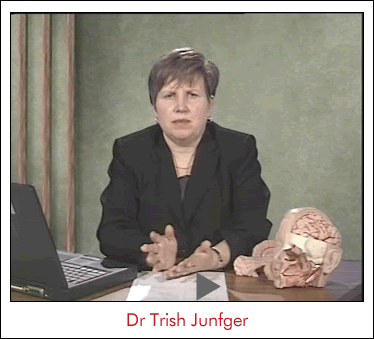- SELF STUDY MODULES
- 1. Intro to TBI
- 2. Communication
- 3. Skills for independence
- 4. Cognitive changes
- 5. Behaviour changes
- 6. Sexuality
- 7. Case management (BIR)
- 8. No longer available
- 9. Mobility & motor control
- 10. Mental health & TBI:
an introduction - 11. Mental health problems
and TBI: diagnosis
& management - 12. Working with Families
after Traumatic Injury:
An Introduction - 13. Goal setting
- 11.0 Aims
- 11.0A Take the PRE-Test
- 11.1 Mental health & mental illness & TBI
- 11.2 Factors affecting the risk of psychiatric illness after a TBI
- 11.3 The brain and psychiatric illness
- 11.4 Severity of a TBI
- 11.5 Types of mental health problems after a TBI
- a) Mood disorders
- b) Psychotic disorders
- c) Anxiety
- d) Personality
- 11.6 Sam : case study
- 11.7 Diagnostic challenges:
- a) Person with TBI
- b) Inherent in the disease
- c) Social environment
- d) Psychiatry and services
- 11.8 Management challenges
- a) Person with TBI
- b) Medical services
- c) Family
- d) Rehabilitation team
- 11.9 Take home messages
- 11.10 Resources
- 11.11 Take the POST-test
11.6 Sam : Case study
i) Introduction
Sam's case study is used in
Section 11.7 Diagnostic challenges and Section 11.8 Management challenges.
You can either view the case study on video or read the transcript of the video.
iii) Video Text
This is a transcript of the video:
Sam was a gentleman who was referred to my practice for management and assessment. He was a 57 year old man, of Middle Eastern origin, and his English language skills were very poor. He came to the initial and all subsequent assessments with a family member. When Sam was first seen he provided virtually no history, he was withdrawn, he tended to seem to mutter, he was quite agitated and gave very little information.
His son attended the first assessment and gave a history that his father had been injured as a pedestrian being struck by a truck. He was rendered unconscious by the collision and taken to a local hospital for acute care management.
He was managed in a general ward of a general hospital and his initial CT scan demonstrated that he had a right frontal contusion. He had no other neurological impairments, that is he did not have any impairment of his mobility. He also had a past history of previously having a back injury and being an invalid pensioner.
He lived with his son, daughter-in-law and wife in his son's family home and there were a number of grandchildren. The history was that he had not worked in the past 18 years due to the injury to his back. He had a large and extended family with a number of children who all seemed to be very intimately involved in the care of his father.
His original referral problem was a question as to whether or not he was depressed and because he had quite bizarre and disturbed behaviour.
The son acted as the interpreter and this is really not an optimal situation clinically but the family would not allow for a government provided interpreter to be used because they were concerned with regard to their confidentiality and worried that the wider community from which they would learn about their father's illness. And so each assessment was always done with a family member acting as the interpreter.
When Sam was first referred I had very little information about the severity of his injury. I had no neuropsychometric assessment and no information with regards to where the injury occurred or how severe it was. Subsequently it emerged that his period of posttraumatic amnesia was anywhere between two weeks and two months because he left hospital while on weekend leave in posttraumatic amnesia and never returned.
At the time that he was referred he was sent by a brain injury service who had only seen him on one occasion and this was some 9-10 months after his original injury. The history I got was that he had hallucinations, he believed that people were talking to him constantly, he was not sleeping at night, he was very agitated, he had both urinary and faecal incontinence, he had the multiple pain complaints, was depressed and as it emerged, after I first saw him, he had recently been arrested for stalking and attempted murder and he was pursuing someone that the family had previously known and had been found outside that person's home having driven a car, unlicensed, but with a weapon in the car which was a knife, and because of his inability to communicate adequately he was charged and spent two days in Long Bay Jail before the family could extract him from hospital.

